Curriculum vitae: What is important? Structure, content, useful tips
The CV is the most important part of your application. It tells you everything you need to know about it. The CV helps recruiters to decide whether you are suitable for the job. You will learn how to use your CV correctly to highlight your strengths. By creating a good and correct CV, you will learn to better understand your weaknesses and what skills you need to develop. At the end of the article you will find a free CV template waiting for you.

Table of contents
- What is a CV?
- What do recruiters look for in a CV and what is particularly important to them?
- Correct structure of the CV
- Classic and modern CVs: differences
- The CV using a concrete example
- 5 important tips for creating a CV
- The CV is only one part of the application
- Download free application and CV templates
What is a CV?
A CV is a document that lists a person's professional and academic career. It contains information about:
- Personal details (name, contact information)
- Professional experience (previous jobs, responsibilities, achievements)
- Education (schools, universities, degrees)
- Qualifications and skills (certificates, language skills, technical skills)
- Additional information (volunteer activities, hobbies, interests)
The CV is usually submitted with job applications to give the employer an overview of the applicant's suitability.
What do recruiters look for in a CV and what is particularly important to them?
Recruiters pay particular attention to the applicant's professional experience. They check where someone has worked, what tasks were undertaken and what results were achieved. This information shows whether the applicant is suitable for the job.
Qualifications and education are also important. Degrees, certificates and further training show specialist knowledge and a willingness to develop professionally.
The applicant's adaptability is another important aspect. Signs of this are part-time activities, voluntary work or special projects.
Personal qualities such as communication skills, leadership and problem-solving skills are in demand in many positions. A CV should highlight these soft skills.
In summary, recruiters are looking for a mix of technical expertise and soft skills. A CV should give a comprehensive impression of the applicant and show how they could fit in with the company. It is important to clearly outline achievements and qualifications and emphasize personal qualities.
Correct structure of the CV
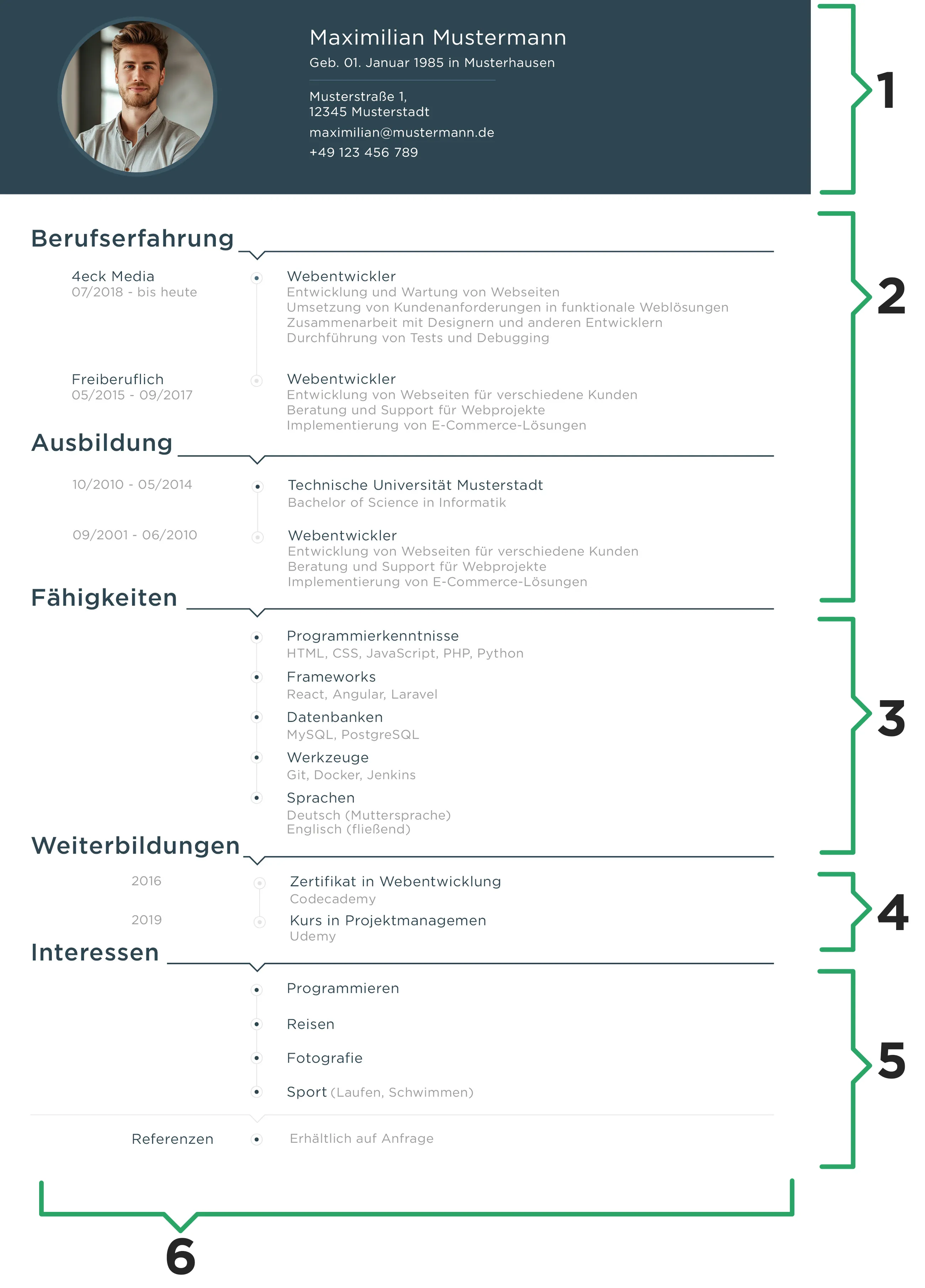
- Personal details: Basic information such as the applicant's name, address, telephone number and e-mail address are given here. Sometimes the date and place of birth and nationality are also listed.
- Work experience and education: This section includes professional career and educational background. Work experience includes positions held, names of companies, length of employment and significant duties or achievements. The education section lists the educational institutions attended, degrees earned and periods of study.
- Knowledge and skills: Specific skills such as language skills, computer skills and other relevant skills relevant to the position sought are outlined here.
- Further training: This section of the resume lists additional qualifications and continuing education beyond basic education. This includes seminars, workshops, certificates and other further training measures.
- Interests and hobbies: This section is optional and gives the employer an insight into the applicant's personality. Hobbies, volunteer activities or other interests that match the applicant's personality or could be relevant to the position can be listed here.
- No more than two pages: An effective resume should be clear, concise and limited to a maximum of two pages. This limitation forces the applicant to focus on the essential information and present it in a compact way.
Classic and modern CVs: differences
CVs can vary in their structure and design, but there are basically two main types: the classic and the modern CV. Both formats serve the same purpose of providing an overview of an applicant's career, education and skills, but they do so in different ways.
Classic CV:
- Formatting: clearly structured, uncluttered and without graphic elements. The information is arranged in reverse chronological order, starting with the most recent position.
- Design: Minimalist, usually black and white, without photos or color accents.
- Content: Focuses on professional experience, educational qualifications and formal qualifications. Personal interests or hobbies are rarely and briefly mentioned.
- Target group: Applications in traditional sectors such as finance, law or administration, where professionalism and formality are valued.
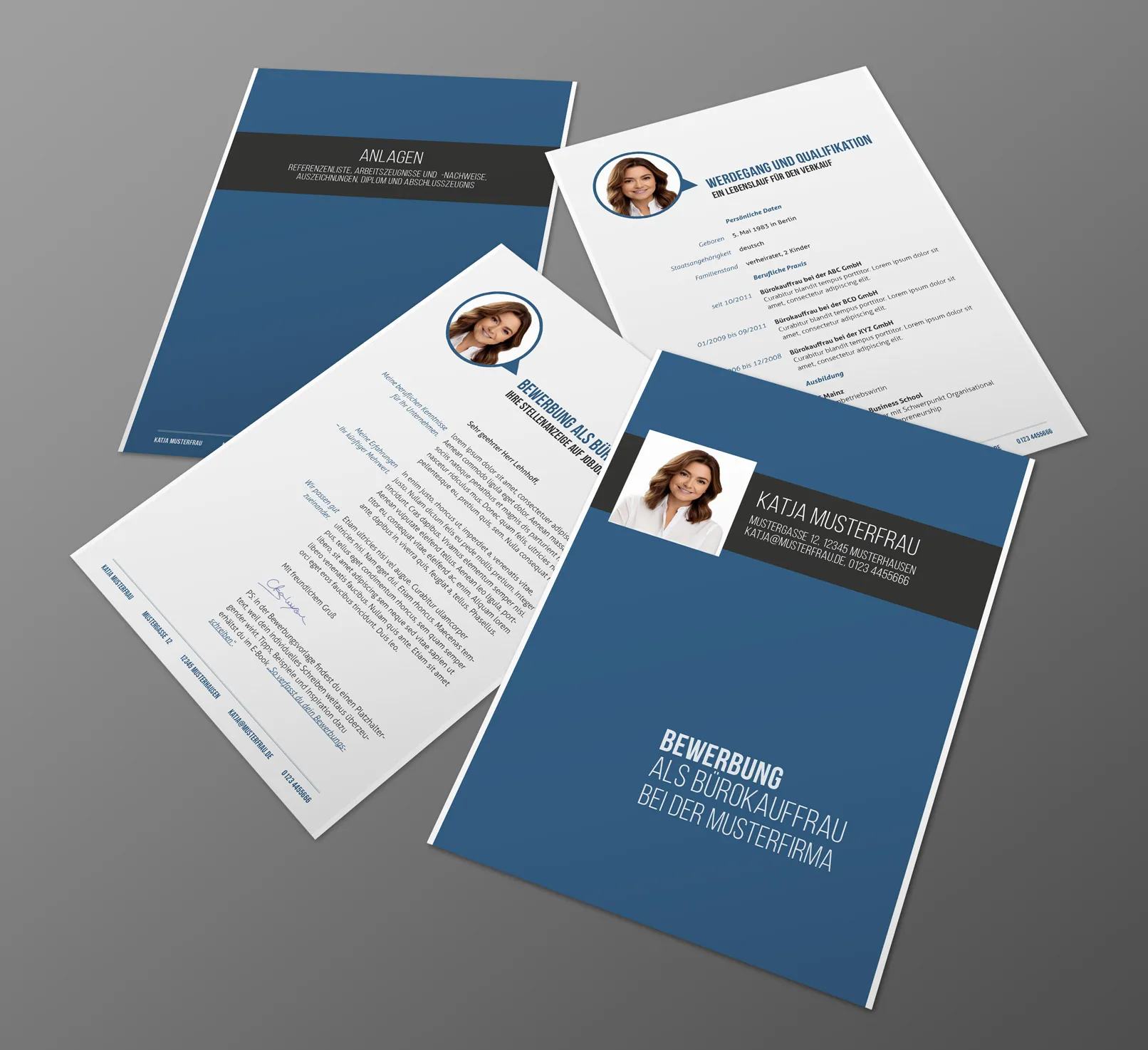
Modern CV:
- Formatting: may feature more creative structures, including infographics or a less strict chronological order to highlight particular skills or projects.
- Design: Use of color, possibly a professional photo of the applicant, and graphic elements to highlight certain areas or improve readability.
- Content: In addition to the standard information, soft skills, personal projects or volunteer activities are also emphasized. The focus is on showing the applicant's personality and individual strengths.
- Target group: Suitable for creative professions, start-ups or industries that value innovation and originality.
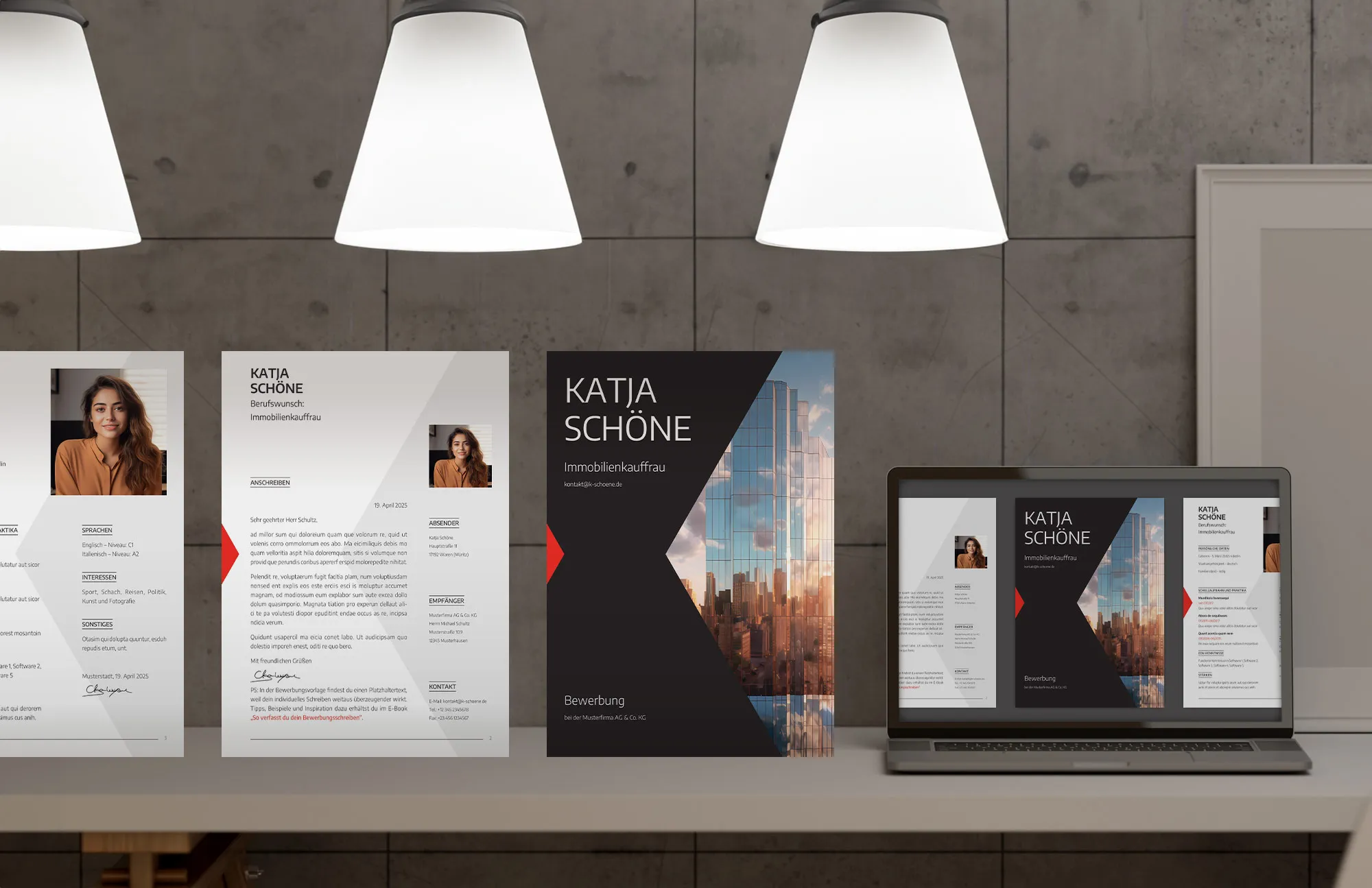
While the classic CV impresses with its structure and simplicity and draws attention to professional achievements, the modern CV offers more scope to emphasize an applicant's uniqueness and present their skills in a more visually appealing way. The choice between a classic and a modern CV ultimately depends on the position and industry you are applying for.
The CV using a concrete example
Personal details
In this section, you provide the basic personal details that will enable the employer to contact you.
Example:
- Surname and first name: Tobias Mustermann
- Date of birth: 30.12.1990
- Contact information: Phone: 0123 456 789, e-mail: email@name.de
- Address: Musterstraße 14, 10405 Berlin
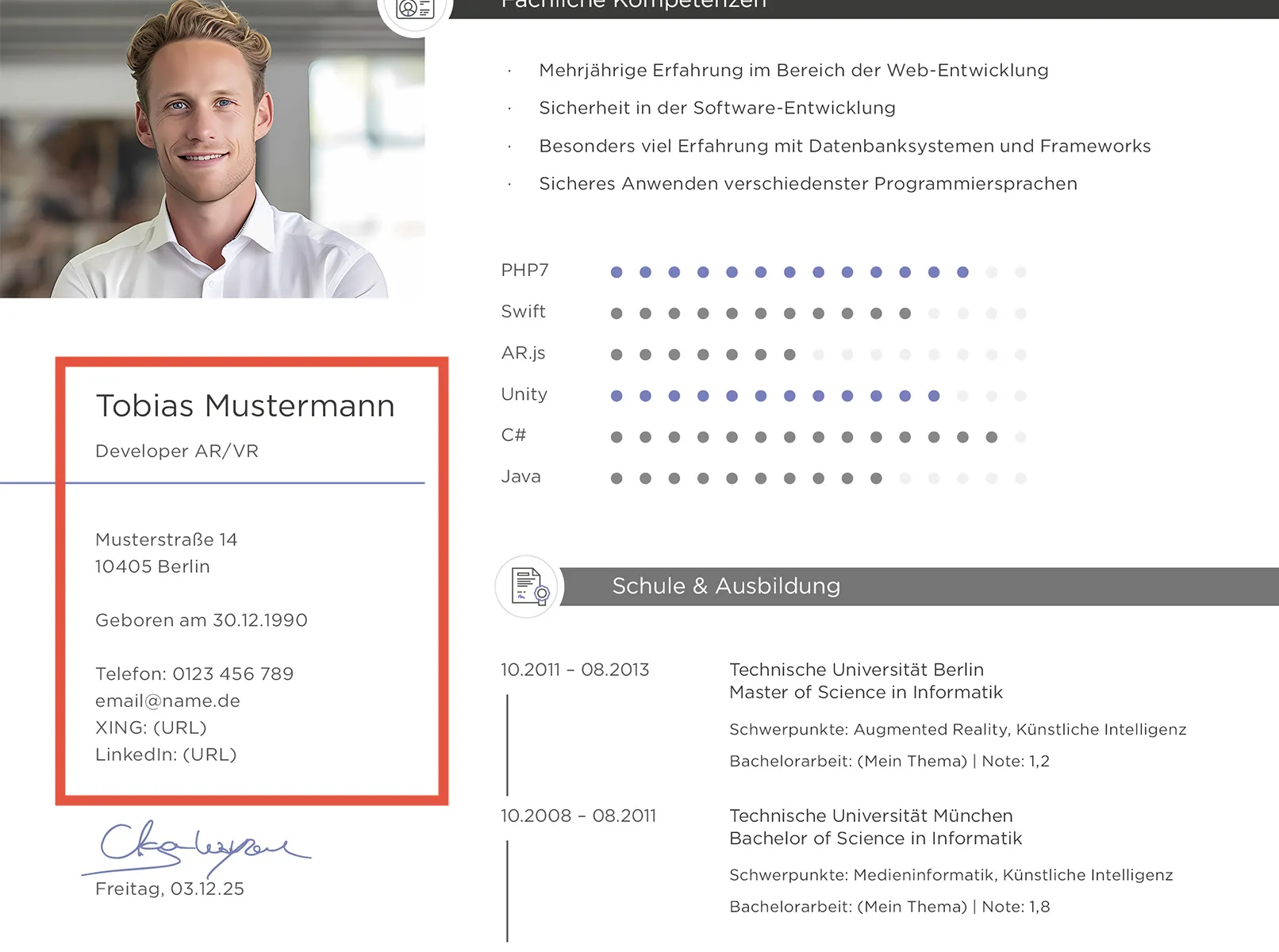
Education
Here you list your educational institutions and your qualifications.
Example:
- Higher education: Technical University of Berlin. Master of Science in Computer Science
- School education: Isar Gymnasium Munich. A-levels
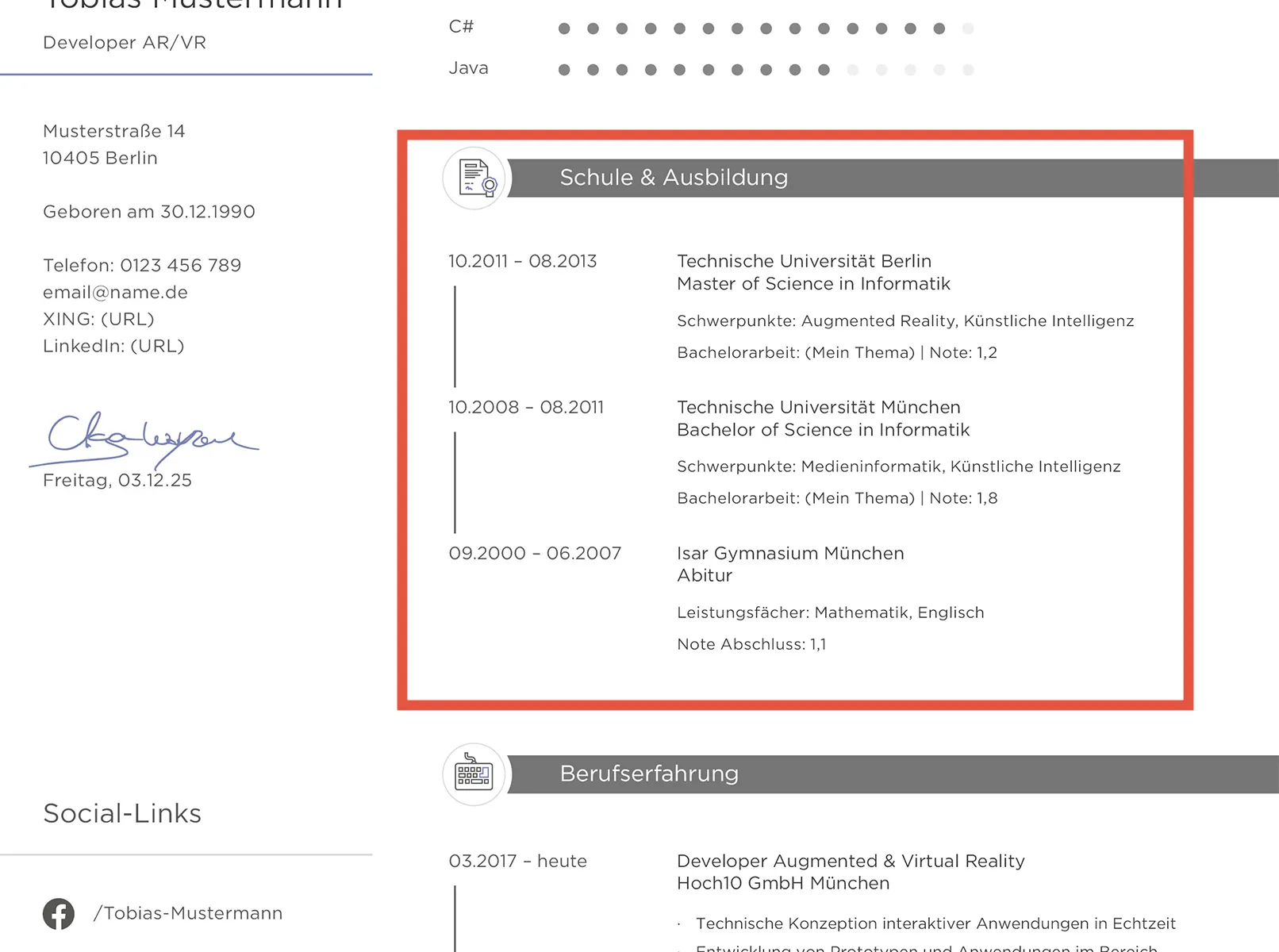
Work experience
Here you provide information about your professional experience, including positions and main tasks.
Example:
Developer for Augmented & Virtual Reality at Hoch10 GmbH, Munich
- Technical conception of interactive real-time applications
- Development of prototypes and applications in the field of AR/VR
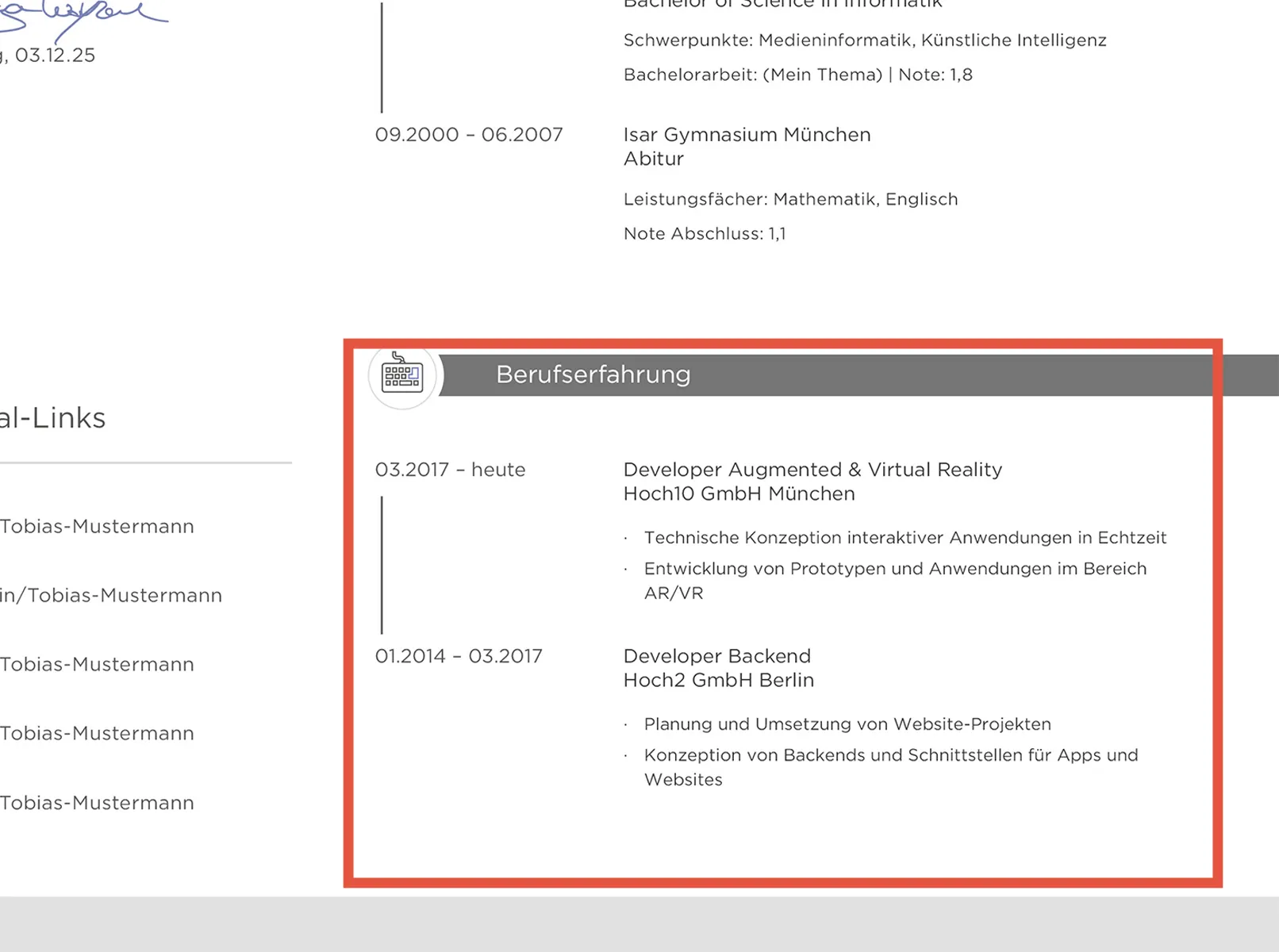
Skills and qualifications
Here you list your most important skills and qualifications that could be useful for the new position.
Example:
- Language skills: English - business fluent | Test of English for International Communication
- Software skills: MS Office, Adobe Photoshop, Google Analytics
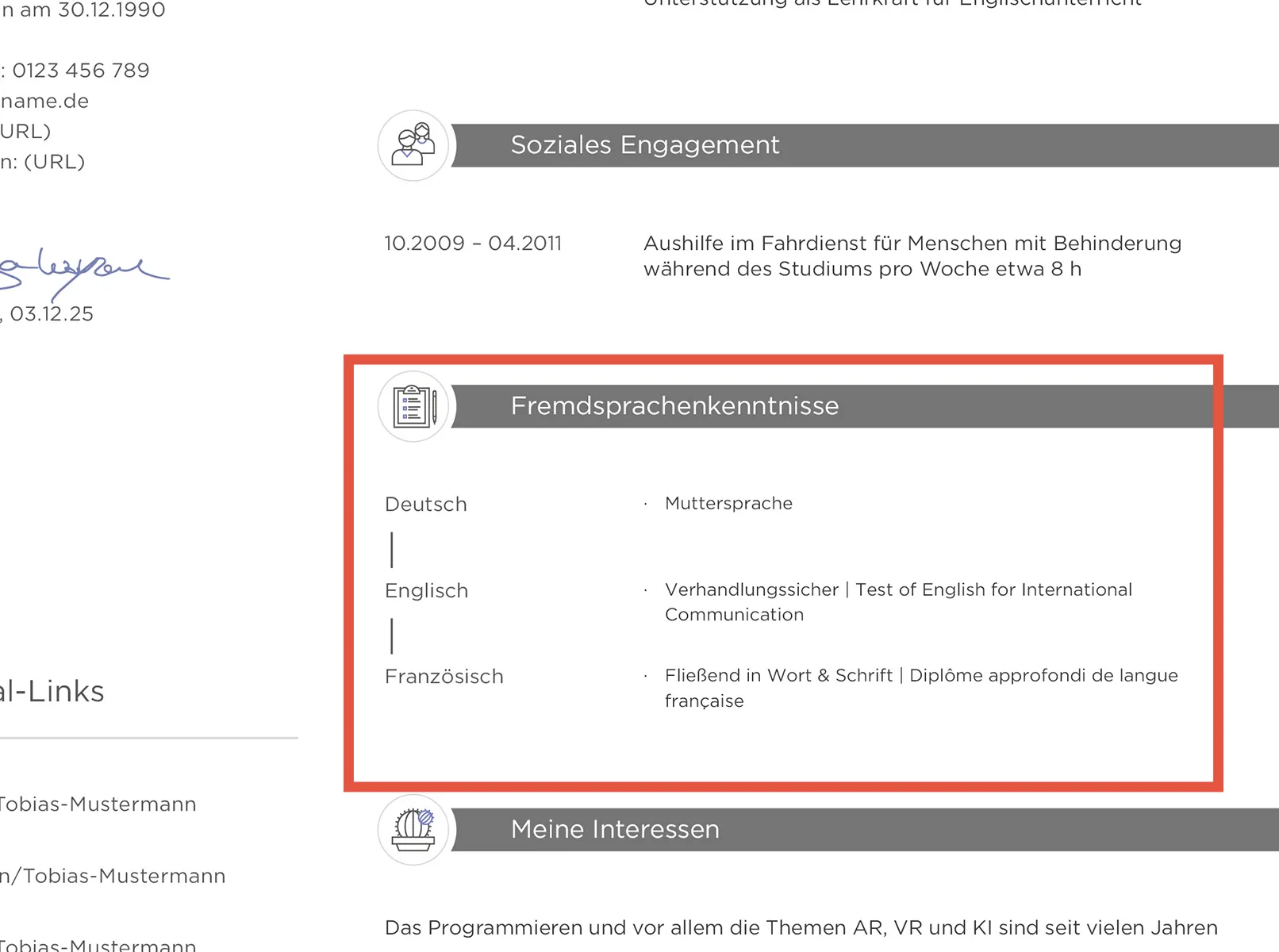
Additional information
Here you can enter any other information that might be useful for the employer.
Example:
- Driver's license.
- Participation in voluntary projects for environmental protection.
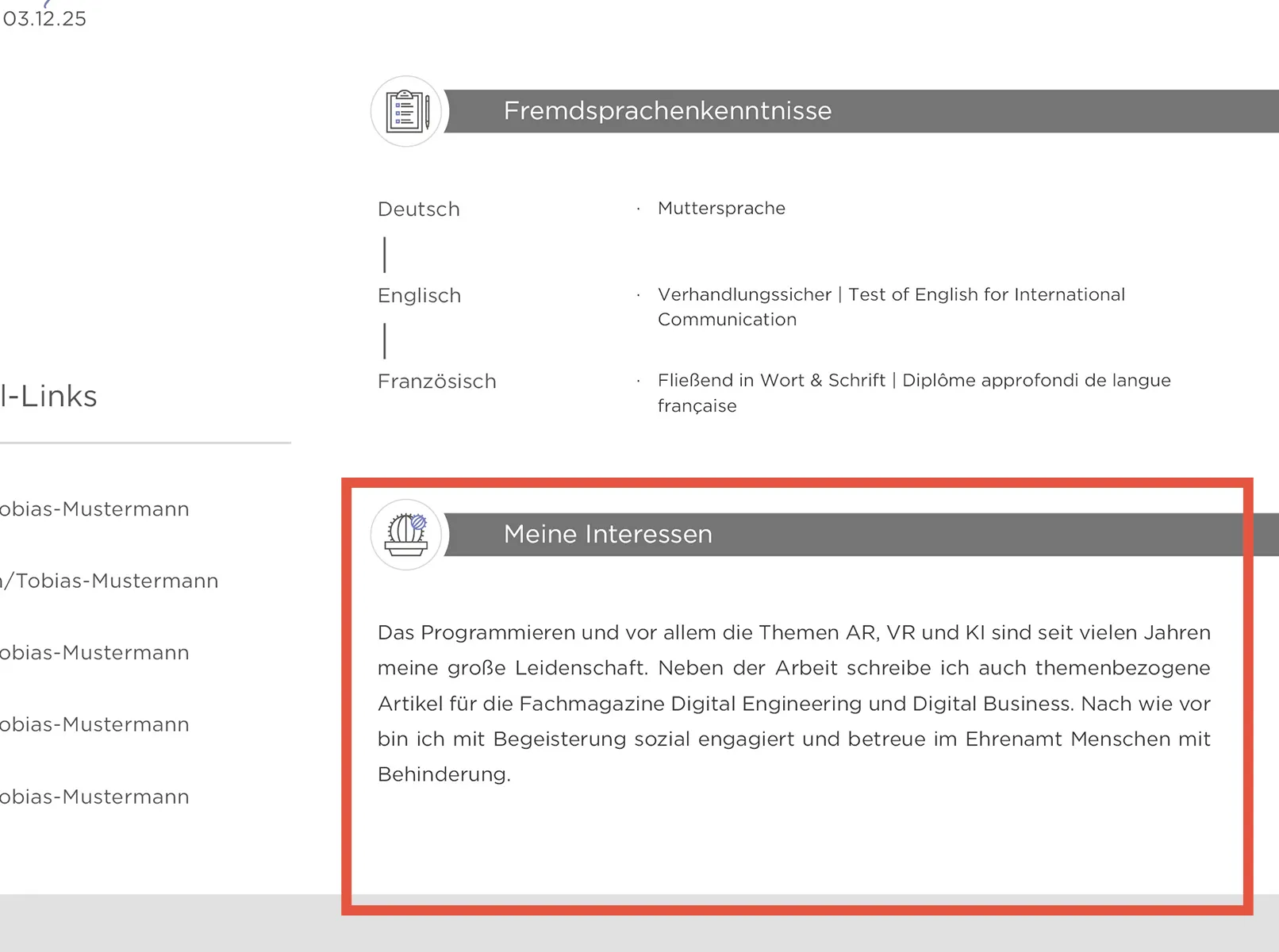
5 important tips for creating a CV
A well-designed CV is the key to landing your dream job. Here are five important tips to help you create an impressive CV:
- Clarity and structure: make sure your CV is clear and well structured. Use clear headings for individual sections such as work experience, education, skills and qualifications. A well-organized CV makes it easier for employers to find the most important information quickly.
- Highlight relevant information: Focus on the experience and skills that are most relevant to the position you are seeking. Avoid overloading your CV with irrelevant details. Use bullet points to emphasize your most important tasks and achievements.
- Adapt to the job ad: Tailor your resume to each specific job ad. Read the job description carefully and include relevant keywords and requirements in your resume. This shows the employer that you have exactly the qualifications they are looking for.
- Professional design and formatting: An appealing design can make all the difference. Use a professional layout and make sure you use consistent fonts and font sizes. Make sure your CV is no longer than two pages and has enough white space to ensure good readability.
- Grammar and spelling: Errors in grammar and spelling can leave a bad impression. Check your CV carefully for errors and ideally have it proofread by a second person. An error-free CV shows care and professionalism.
The CV is only one part of the application
A CV is undoubtedly an important part of your application, but it is not everything. A complete application consists of several parts that together provide a comprehensive picture of your qualifications and suitability for the position. Here are the other important components:
- Cover letter: The cover letter is your opportunity to introduce yourself to the potential employer and explain why you're right for the job. It should address the specific requirements of the job advertisement and emphasize your motivation and enthusiasm for the position.
- References and certificates: Attach copies of your most important references and certificates. These documents prove your education and additional qualifications. They can also include relevant further education and training.
- Work samples: In some industries, especially in creative professions, work samples are an important part of the application. They show the employer your skills and previous work. Choose samples that are particularly relevant to the position you are applying for.
- References: References from previous employers or professors can strengthen your application. They give the employer an insight into your work ethic and reliability. Make sure you have permission from the reference to provide their contact details.
By putting all these elements together carefully and professionally, you increase your chances of standing out and being invited for an interview.
Download free application and CV templates
Now you know more and can create your own CV for your future job. All you need is a download link. Download the set of application and CV templates to make your application perfect.
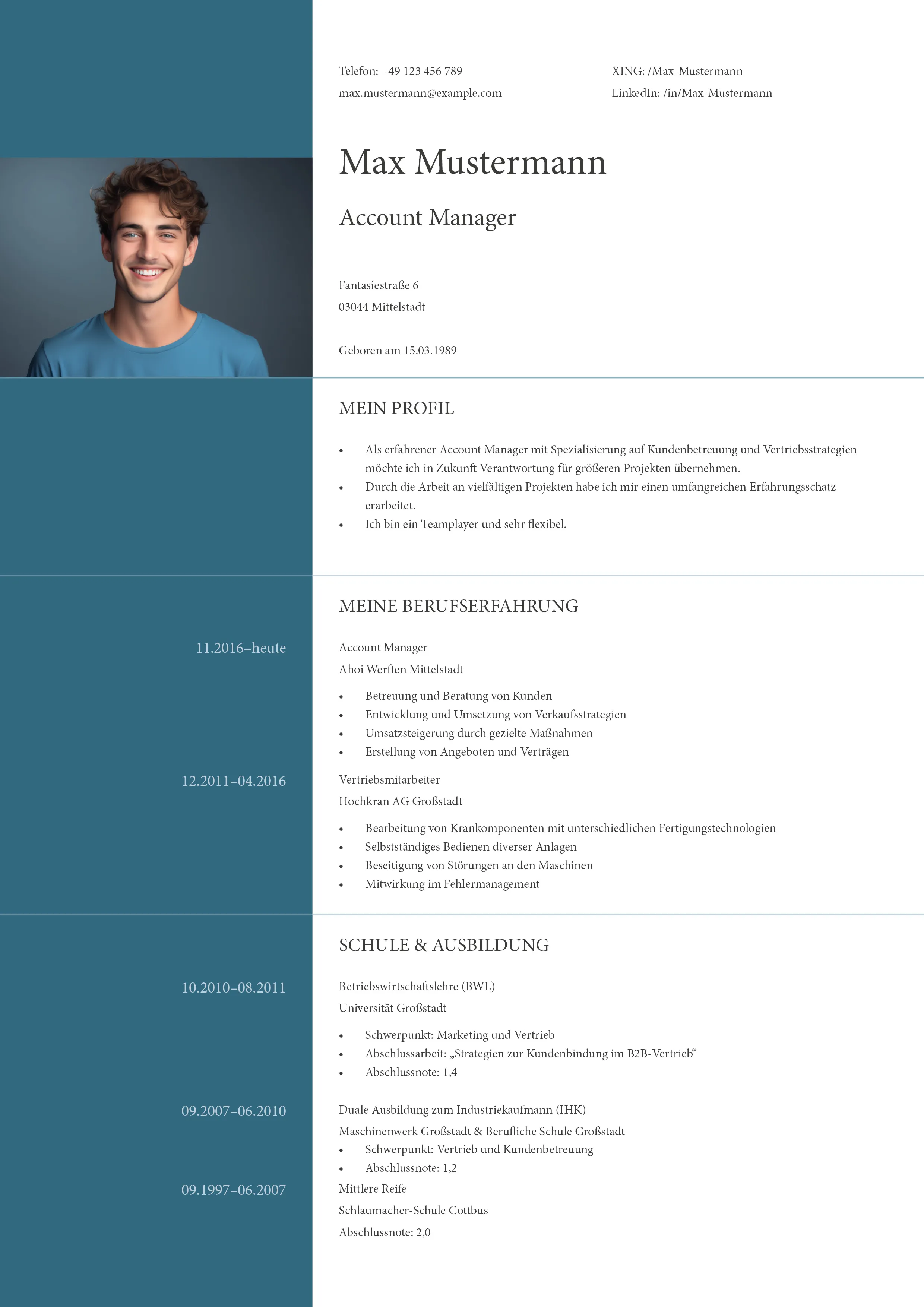
From Vitalii Shynakov
